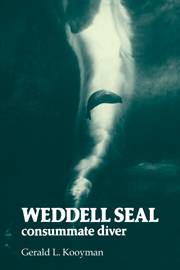Book contents
- Frontmatter
- Contents
- Preface
- Dedication
- Map
- 1 McMurdo Sound
- 2 The Weddell seal
- 3 Breeding, birth, and growth
- 4 Cold
- 5 Diving behavior: Poseidon's pride
- 6 Physiology of diving
- 7 Food habits and energetics
- 8 Under-ice orientation (summer day – winter night)
- 9 Distribution, abundance, and mortality
- 10 Future prospects
- References
- Index
9 - Distribution, abundance, and mortality
Published online by Cambridge University Press: 21 May 2010
- Frontmatter
- Contents
- Preface
- Dedication
- Map
- 1 McMurdo Sound
- 2 The Weddell seal
- 3 Breeding, birth, and growth
- 4 Cold
- 5 Diving behavior: Poseidon's pride
- 6 Physiology of diving
- 7 Food habits and energetics
- 8 Under-ice orientation (summer day – winter night)
- 9 Distribution, abundance, and mortality
- 10 Future prospects
- References
- Index
Summary
Out, out brief candle Life's but a walking shadow.
Shakespeare, MacbethOccasionally, Weddell seals have been found north of the antarctic convergence (Erickson & Hofman, 1974). The most northerly record is a sighting off Uruguay at a latitude of 35°S. Several other sightings have been reported in various parts of South America and New Zealand. There is one record for Australia (Fig. 9.1). These are all wandering animals, and they do not represent established or incipient breeding colonies.
The most northerly breeding colony is just south of the antarctic convergence in Larsen Harbor, at the southern tip of South Georgia Island. In this colony, between 25 and 30 pups are born between August and September each year. The total population in the harbor area is perhaps 85 animals. There are only occasional sightings elsewhere on the island.
Weddell seals are present constantly around the entire coastline of Antarctica. At suitable places throughout this area, breeding colonies may be found at the appropriate time of year. Some of the largest concentrations of Weddell seals have been noted in the Weddell Sea, where one survey recorded from 15 to almost 35 animals per square km.
The best census data and natural history observations have been obtained near research stations. For example, some of the earliest work was done by Alton Lindsey in the Bay of Whales. Lindsey noted as many as 500 seals in the area. In Adelie Land near the French base, Dumont D'Urville, a few hundred seals reside.
- Type
- Chapter
- Information
- Weddell SealConsummate Diver, pp. 109 - 120Publisher: Cambridge University PressPrint publication year: 1981



